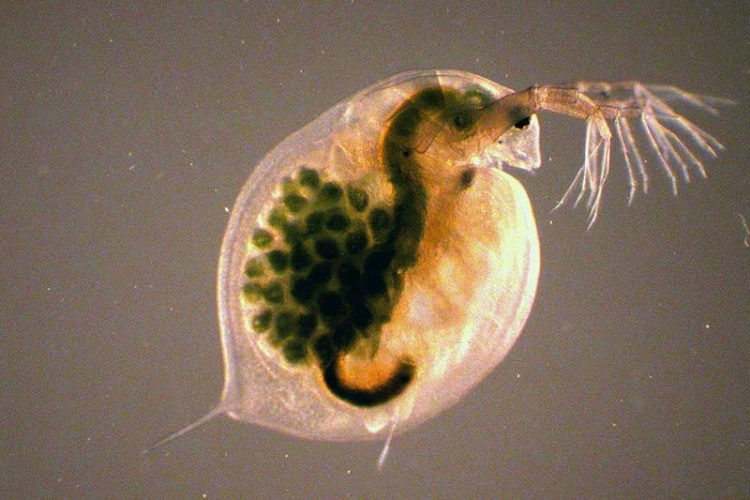Swiss Scientists Explain Evolution of Extreme Parasites

The water flea (Daphnia magna) serves as the host of the newly described parasite. The animal measures about 4mm in length. Dieter Eber, University of Basel
Zoologists at the University of Basel in Switzerland have now discovered a new parasite species that represents the missing link between fungi and an extreme group of parasites. Researches are now able to understand for the first time the evolution of these parasites, causing disease in humans and animals. The study has been published in the latest issue of the scientific journal Proceedings of the National Academy of Sciences (PNAS).
Parasites use their hosts to simplify their own lives. In order to do so, they evolved features that are so extreme that it is often impossible to compare them to other species. The evolution of these extreme adaptations is often impossible to reconstruct.
The research group lead by Prof. Dieter Ebert from the Department of Environmental Science at the University of Basel has now discovered the missing link that explains how this large group of extreme parasites, the microsporidia, has evolved. The team was supported in their efforts by scientists from Sweden and the U.S.
Microsporidia are a large group of extreme parasites that invade humans and animals and cost great damage for health care systems and in agriculture; over 1,200 species are known. They live inside their host's cells and have highly specialized features:
They are only able to reproduce inside the host's cells, they have the smallest known genome of all organisms with a cell nucleus (eukaryotes) and they posses no mitochondria of their own (the cell's power plant). In addition, they developed a specialized infection apparatus, the polar tube, which they use to insert themselves into the cells of their host. Due to their phenomenal high molecular evolution rate, genome analysis has so far been rather unsuccessful: Their great genomic divergence from all other known organisms further complicates the study of their evolutionary lineage.
Between fungi and parasite
The team of zoologists lead by Prof. Dieter Ebert has been studying the evolution of microsporidia for years. When they discovered a new parasite in water fleas a couple of years ago, they classified this undescribed species as a microsporidium, mostly because it possessed the unique harpoon-like infection apparatus (the polar-tube), one of the hallmarks of microsporidia.
The analysis of the entire genome had several surprises in store for them: The genome resembles more that of a fungi than a microsporidium and, in addition, also has a mitochondrial genome. The new species, now named Mitosporidium daphniae, thus represents the missing link between fungi and microsporidia.
With the help of scientists in Sweden and the U.S., the Basel researchers rewrote the evolutionary history of microsporidia. First, they showed that the new species derives from the ancestors of all known microsporidians and further, that the microsporidians derive from the most ancient fungi; thus its exact place in the tree of life has finally been found.
Further research confirms that the new species does in fact have a microsporidic, intracellular and parasitic lifestyle, but that its genome is rather atypical for a microsporidium. It resembles much more the genome of their fungal ancestors.
Genome modifications
The scientists thus conclude that the microsporidia adopted intracellular parasitism first and only later changed their genome significantly. These genetic adaptations include the loss of mitochondria, as well as extreme metabolic and genomic simplification. “Our results are not only a milestone for the research on microsporidia, but they are also of great interest to the study of parasite-specific adaptations in evolution in general”, explains Ebert the findings.
Original source
Haag, K.L., James, T.Y., Pombert, J.-F., Larsson, R., Schaer, T.M.M., Refardt, D. & Ebert, D. 2014.
Evolution of a morphological novelty occurred before genome compaction in a lineage of extreme parasites
Proceedings of the National Academy of Sciences, USA, 13. Oktober 2014) www.pnas.org/cgi/doi/10.1073/pnas.1410442111
Further information
Prof. Dieter Ebert, Department for Environmental Science, Zoological Institute, phone: +41 (0)61 267 03 60, fax +41 (0)61 267 03 60, email: dieter.ebert@unibas.ch
Media Contact
More Information:
http://www.unibas.chAll latest news from the category: Life Sciences and Chemistry
Articles and reports from the Life Sciences and chemistry area deal with applied and basic research into modern biology, chemistry and human medicine.
Valuable information can be found on a range of life sciences fields including bacteriology, biochemistry, bionics, bioinformatics, biophysics, biotechnology, genetics, geobotany, human biology, marine biology, microbiology, molecular biology, cellular biology, zoology, bioinorganic chemistry, microchemistry and environmental chemistry.
Newest articles

“Nanostitches” enable lighter and tougher composite materials
In research that may lead to next-generation airplanes and spacecraft, MIT engineers used carbon nanotubes to prevent cracking in multilayered composites. To save on fuel and reduce aircraft emissions, engineers…

Trash to treasure
Researchers turn metal waste into catalyst for hydrogen. Scientists have found a way to transform metal waste into a highly efficient catalyst to make hydrogen from water, a discovery that…

Real-time detection of infectious disease viruses
… by searching for molecular fingerprinting. A research team consisting of Professor Kyoung-Duck Park and Taeyoung Moon and Huitae Joo, PhD candidates, from the Department of Physics at Pohang University…





















